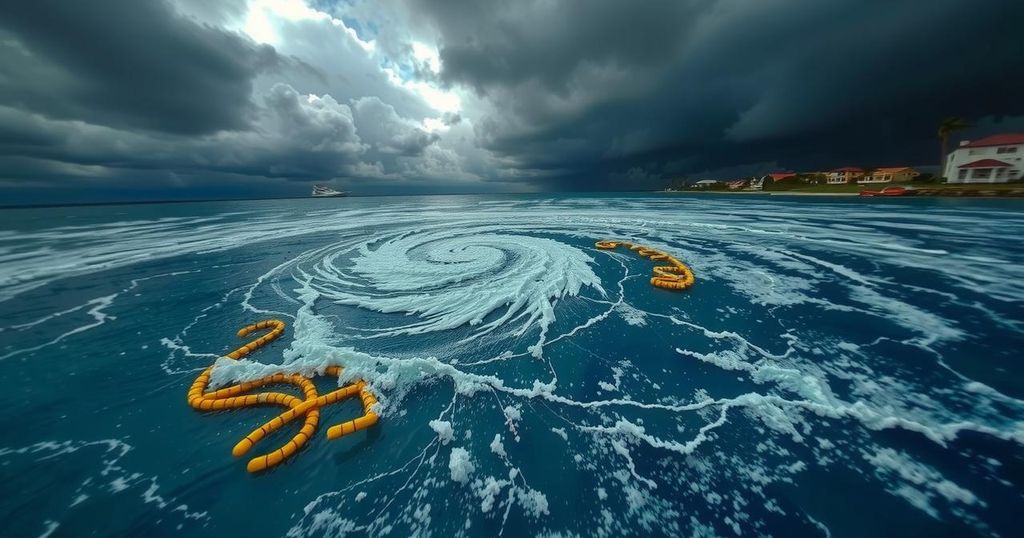Tropical Storm Oscar weakened after causing devastation in Cuba, resulting in seven fatalities and heavy rainfall. It became the smallest hurricane recorded, surprising forecasters with its intensity. The storm’s remnants are moving toward the Bahamas, with expected rainfall. Concurrently, Hurricane Kristy formed in the eastern Pacific but poses no threat to land.
Tropical Storm Oscar diminished in strength Tuesday as it made its way toward the Bahamas, following its landfall in Cuba where it was classified as a Category 1 hurricane. The storm resulted in the deaths of at least seven individuals and produced significant rainfall on a nation already grappling with an unrelated massive power outage. The remnants of Oscar were detected approximately 75 miles (115 kilometers) east-southeast of Long Island in the Bahamas during the afternoon, with maximum sustained winds decreasing to 35 mph (55 kph) while moving northeast at a speed of 12 mph (19 kph), as reported by the National Hurricane Center in Miami. Forecasters anticipated that Oscar’s remnants would generate up to 4 inches (10 centimeters) of rain across southeastern Bahamas and the Turks and Caicos Islands. Oscar established a record as the smallest hurricane ever documented, with a wind field measuring roughly 6 miles (10 kilometers) across. Its unexpected intensity surprised meteorologists, particularly as it made landfall on Grand Inagua Island in the Bahamas on Saturday, followed by another landfall in eastern Cuba late Sunday, before it executed a sudden return toward the Bahamas. “It’s not often we see a colossal failure in hurricane forecasting,” noted Michael Lowry, a hurricane specialist and storm surge expert, acknowledging that forecasting models did not predict any strengthening into a hurricane. Oscar unleashed at least 15 inches (38 centimeters) of rain in regions of eastern Cuba on Monday, with alerts about severe flooding and potential landslides. The fatalities were confirmed in the province of Guantánamo. The storm’s timing coincided with Cuba’s recovery efforts from a significant blackout that instigated small protests and resulted in government warnings regarding potential unrest. According to long-range forecasts, meteorologists predict the possibility of another storm developing in the central Caribbean in approximately one week. “One last gasp may be in store for the Atlantic as we turn the calendar to November,” said Lowry. The National Oceanic and Atmospheric Administration had previously projected an above-average Atlantic hurricane season due to unprecedented warm ocean temperatures, anticipating 17 to 25 named storms before the season concludes, with four to seven major hurricanes rated Category 3 or higher. In a related development, Hurricane Kristy formed in the eastern Pacific Ocean, with forecasts indicating it would remain over open waters, posing no immediate threat to land. Kristy was located 590 miles (950 kilometers) west-southwest of Acapulco, Mexico, moving westward at a speed of 18 mph (30 kph) with maximum sustained winds of 75 mph (120 kph). No coastal watches or warnings are currently in effect for this storm.
The Atlantic hurricane season extends from June 1 to November 30 and is characterized by varying storm activity influenced by ocean temperatures and atmospheric conditions. This period has annually generated numerous named storms, with a focus on understanding forecasting models to predict storm intensity and paths accurately. Tropical Storm Oscar’s unique characteristics, including its size and unexpected wind strength, provide critical data for future forecasting efforts and underscore the challenges faced by meteorologists. The National Oceanic and Atmospheric Administration’s predictions of an above-average season highlight the importance of preparedness in coastal areas susceptible to hurricane threats.
In summary, Tropical Storm Oscar significantly impacted Cuba, leading to fatalities and severe flooding, before weakening as it approached the Bahamas. The event highlights forecasting challenges in meteorology, illustrating the need for ongoing research and refinement of models to improve prediction accuracy. As the hurricane season continues, further storm developments are anticipated, necessitating sustained vigilance and preparedness among affected regions.
Original Source: gvwire.com






